Family News - 2010 September 14th
Contents
- A word from the Superior general
- Father Etchecopar wrote...
- Betharram: Our Lady of Calvary
- The journey of a lay Betharramite
- 5 minutes wtih Fr José Gogorza
- The experience of Betharram in China (8)
| format PDF |
A word from the Superior general
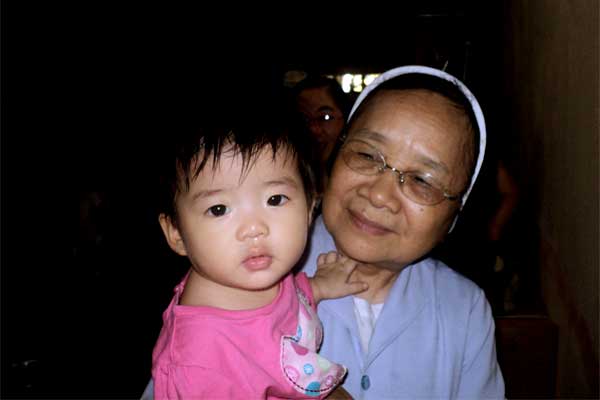
Blessed are the pure of heart
When speaking of mankind the Bible often uses the word heart, not in the sense of the vital organ which pumps blood round the body, but in the sense of affection as it is understood today. The heart corresponds to the inner world of the individual: his thoughts, his passions, his desires, his motives and even his decisions. The heart is the seat of the moral person (Mat 15, 19). (The Catechism of the Catholic Church 2517.) In the heart the success or the failure of the person is acted out. The heart conceals what is best in man: You will love the Lord, your God, with all your heart; (Deut 6,5) It also conceals what is worst in man: the heart of man is complicated and sick (Jer 17,9). The meeting with God takes place also in the heart. The heart provides shelter for the joys and wounds of life. There exists a whole anthropology, pedagogy and wisdom of the heart.
And so each one should pay attention to his heart to see what is troubling it, to make out its motions, to discern them and decide in favour of what enhances, makes progress, out reaches us in love to aim at the real happiness for which we have been created. This is the result of the motions directing us towards an opening to God, to others and to the gift of ones life. On the other hand, motions which always aim at self protection confine us within ourselves and finally lead to frustration.
Jesus, the Incarnate Word, also has a heart, a heart which is straight and pure, which can be known through his bearing. It is a heart which is meek and humble, obedient and generous, merciful and willing to help. He multiplies the bread and cares for the sick because he is touched by the situation in which those he meets find themselves. (Mt 14,14 ss) He praises the Father in his emotion at seeing the Fathers love for the humble (Lk 19,21). Instead of self satisfaction he tries to please the Father, who sent him, in every way. (Mk 1,35-39; Jn 6,15) When he realises the difficulty of the mission, instead of running away, he sets his face and takes the road for Jerusalem (Lk 9,51; Is 50). At the height of his passion, instead of cursing God because of his sufferings, full of the dignity of Son and brother, he believes that the Fathers love will not abandon him (Lk 23, 43 46) He is humble enough to accept the love of the penitent woman (Lk 7,37 39); he is capable of kneeling before his friends to wash their feet. (Jn 13, 1-7) Instead of crying out for revenge, he forgives his torturers. Instead of wishing the death of the sinner, he greets him, eats at his table, and gives up his life on the cross for the forgiveness of sin (Lk 22, 19-20). The wound in his pierced side lets us see his heart completely emptied, there is nothing left; he gave his life (blood) to his Father so that all may have life (water).
Contemplation of the Heart of Jesus filled St Michael Garicoits with such amazement that he cried out: Oh my model! What calm, what self effacement, what gentle attention, what exterior, what interior! But above all, what a heart, what love, what indulgence, what patience, in the midst of that ocean of pain! (DS 48). But he is not content by being amazed or of crying out, he wants his heart to be like the heart of Jesus; he will reach that thanks to all the opposition he would meet in the foundation of his community: O Divine Heart, you want to become my heart. Yes, my poor old heart, make way for the Heart of Jesus! O Heart of Jesus, take its place! I dont want to refuse you anything else. Cut! Burn! Take! Help me to love you. That will be enough. Amen! Amen! (ibid).
The heart of us disciples, united to the heart of Jesus, our Master, through faith, the sacraments, and the practice of Christian virtues, will be purified little by little. It is no longer a heart of stone to become a heart of flesh (Ez 36,26). The old heart is changed into a new heart (Ez 11,19; Eph 4, 22-25; Col 3, 5-11; Gal 5,16-26). The purification of the heart is achieved by the grace of God, but also by fighting the fight of purity, which supposes, according to the Catechism of the Catholic Church that with Gods grace the recipient of Baptism will prevail:
- By the virtue and gift of chastity, for chastity lets us love with upright and undivided heart.
- By purity of intention which consists in seeking the true end of man ; with simplicity of vision the baptised person seeks to find and to fulfil Gods will in everything. (cf Rm 12,2; Col 1,10)
- By purity of vision, external and internal, by discipline of feelings and imagination, by refusing all complicity in impure thoughts that incline us to turn aside from the path of Gods commandments; appearance arouses yearning in fools.
- By prayer. (CCC 2520)
For this, right from early catechism, through initial formation for religious life, the priesthood or marriage, and throughout the whole of life, the road to purification of the heart must be boldly taken so as to form a heart which is straight, without duplicity, showing the whole of our humanity and without straying from the purpose for which we were created: Purity of heart is the precondition of the vision of God. Even now it enables us to see according to God, to accept others as neighbours; it lets us perceive the human body ours and our neighbours as a temple of the Holy Spirit, a manifestation of divine beauty. (CCC 2519)
Whoever has a purified heart is always coherent in his actions. Whoever neglects the purification of the heart and acts according to his inclinations is living a perpetual contradiction. Now and again his behaviour may even leave much to be desired. And when the problem is pathological it can even lead to a dual existence: just to be left in peace he behaves just as people expect him to; and when there is no facade to be maintained he behaves simply to feel good.
Gaspar Fernandez,SCJ
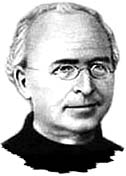 Father Auguste Etchecopar wrote...
Father Auguste Etchecopar wrote...
to his sister Elisabeth, Daughter of Charity, 31st July 1865
For the Christian there is no sorrow which is not followed by a consolation, as real as the body is attached to its shadow. Why does sorrow beget joy in the heart which is truly Christian? It is because sorrow is part of the Cross of Jesus and consequently is the foundation of the hope of heaven. What greater reason, what better source of consolation can our heavenly Father give us than sending us the Cross of Jesus, and with it, if I may say so, a ticket for heaven saying to us: come my child, come and accompany my Son on Calvary; come and help him carry his Cross, and be part of that little band which has chosen for themselves the tears of time and the joys of Eternity.
History
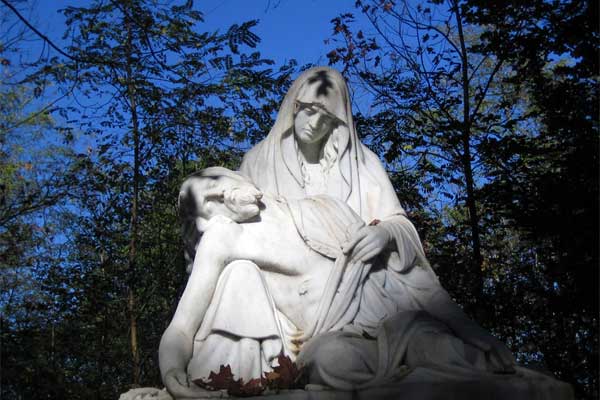
Betharram: Our Lady of Calvary(1)
September 14th, feast of the Exaltation of the True Cross, is celebrated with great solemnity in Betharram. Why? Thanks to the historical research undertaken by Fr Benat Oyhenart, here is the answer, part of which we are publishing today.
Do you know Hubert Charpentier? His heart is in Betharram, for he left his heart in Betharram! The story of the Calvary of Betharram begins with him.
That the sanctuary is ancient is well known; ever since the 11th century, the Crusades and the struggle between the Moors and the Saracens, or following the devotion to Mary as preached by St Fulbert of Chartres (11th century) or St Bernard of Clairvaux (12th century); or a stage on the route to Compostella... Gatarram its old name, is to be found in a Will dated 6th June 1493.
The first story about the image of the Virgin discovered by some shepherds is related by Poire (in 1639) and by Marca (in 1667). Another text has the statue being found by some cattle which had escaped from their herdsman; Bernadette Soubirous mentions it: God has made use of me as he made use of the cattle in Betharram.
As for the story of the little girl saved from drowning, it appears for the first time in 1835; - in a novel! This story was kept up by Fr Jean Sempe, a Capuchin priest known as Fr Joseph. He was the first to undertake the restoration of the Calvary after the French Revolution. The title Our Lady of Betharram will take almost a century to replace that of Our Lady of Calvary.*
In Betharram there is one event which can be certified for sure: the erection of the cross in 1616. Here in lies the source of devotion to the Holy Cross.
The wars of religion and of Count Montgommery led to the destruction of the sanctuary in 1569. However peoples devotion remained steadfast; at Lestelle everybody remained Catholic. In Betharram, Mgr Jean de Salettes, bishop of Lescar, restored the cult in 1615. In July 1616, a statue of the Virgin was enthroned by the archbishop of Auch, Mgr Leonard de Trappes; and on the top of the hill a huge cross was erected.
Two months later, on a neighbouring hillside, five workmen from Montaud were cutting bracken for the bedding for their animals.The day was calm, not the slightest whisper of a storm. Suddenly they heard a gale force wind blowing over the mountains from Betharram. Looking in this direction they could see that the force of the wind had blown the cross to the ground. A few seconds later and when the wind had dropped, they saw the same cross arise alone, surrounded by a brilliant light which formed a kind of crown... (Marcas story, 1667).
At that time when the people of Montaud talk in support of Lestelle, they had to be believed; such was the antagonism between the two villages!
When the truth of the miracle had been confirmed, Mgr de Salettes summoned Hubert Charpentier to Betharram- he was a priest originally from the diocese of Meaux. It was he who joined devotion to the Cross with that to Our Lady; from then onwards honour is paid to Our Lady of Calvary. But why this new devotion? Probably because devotion to the Cross, rather than devotion to Mary could unite the faithful who had remained Catholic and the former Huguenots who had passed through the Reformation.
On arriving in Betharram in 1621, Charpentier set about building a dwelling house for the chaplains and a hostel for the pilgrims. He also had the idea for fourteen stations to be erected between the banks of the Gave and the top of the hill; he traced the sorrowful way; in 1623, right on the top, he erected three big crosses; opposite these he undertook the construction of the chapel of the Sepulchre together with two cells. As the years passed new stations were added Jesus in the Garden of Olives, Jesus betrayed by Judas and the Crowning with Thorns.
The bishop of Lescar allowed Charpentier to co-opt six priests to help with the work. Benefactors were generous; Louis XIII during a visit to Bearn, paid for the construction of the station of the Crowning with Thorns, in memory of his ancestor St Louis who had bought and venerated the Crown of Thorns.**
Meanwhile, in 1638 Hubert Charpentier was summoned back to the Paris region to Suresnes to be precise (today in the diocese of Nanterre) where he built the Calvary of Mount Valerien. The chapel in Betharram, where lies his heart, would be finished later in 1661.
The work which had been undertaken continues thanks to the Chaplains, the Congregation of the Priests of Calvary which he had founded. The chapel of the Holy Sepulchre was finished in 1639 and it is here that the pilgrims go to confession and who can make use of all the many hermitages which are scattered all over the hill side.
The reputation of Betharram was very great in the 17th century. If it is not the second, it must surely be the third most visited sanctuary in the kingdom *** wrote St Vincent de Paul on the 19th June 1659 in a letter to M. Guillaume Cornuel, a priest of the Mission; and to one of his friends he said that he had a plan to open a community of his congregation in Betharram.****
It was only at the beginning of the 18th century that eight chapels were erected. They were adorned with sculptures and paintings. They could nearly talk wrote the historian Touton in 1788. (To be continued)
Beñat Oyhenart,SCJ
* The first image of Our Lady of Betharram holding a branch (rather discretely in fact) is the painting by Alexandre Renoir in 1845.
** For it, and for a portion of the True Cross and other relics of the Passion which he had acquired, Louis IX had the Sainte Chapelle built in the Ile de la Cite in Paris.
*** The other two could possibly be Chartres and Le-Puy-en-Velay.
**** Five months previously the same Vincent de Paul had written to Canon Cruchette of Tarbes about his reservations concerning this project: It is true that we had thought of Betharram for our little Company; the late M. Charpentier was the first to propose it to me, 20 years ago, but so far God has not deemed us worthy to serve him in such a holy place.
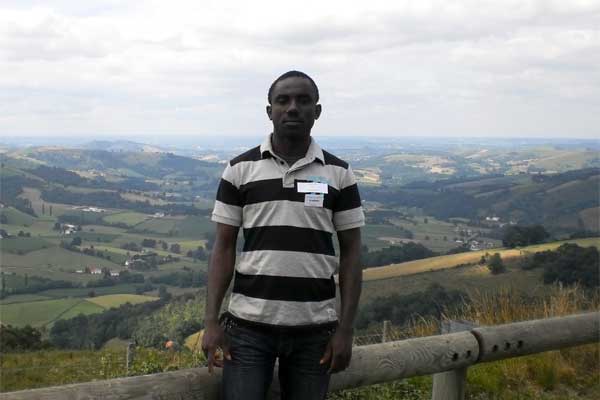
The journey of a lay Betharramite
At the end of July, the lay Associates in France celebrated their 20th anniversary. A young Associate from Ivory Coast tells us what brought him to Betharram and how he spent those days.
Ever since the year 2000 as a member of the Ne Me Fraternity I have been enjoying the same Betharramite spirituality with the religious in Adiapodoume: each one receives his share of grace following in the footsteps of our Lord Jesus, as he tries to be meek and humble of heart just like St Michael Garicoits, and within the limits of his station in life.
In 2009 and after trying for the third time, I obtained from the Ivory Coast a student grant to help me prepare my PHD in Physics at the University of Rouen. I am looking into cancer research so as to detect tumours early on and thus be assured of a better treatment for the patients.
In the context of this scientific work which is both exciting and challenging I gradually discovered my new surroundings. I arrived therefore in France on the 16th November, passing from 30 centigrade at home to the Normandy climate which, according to the locals has been very tough this year. For a student in an unknown environment, cold and loneliness get on very well together! Luckily I made the discovery of a true friend a cousin of a priest from Betharram; with him I found the family warmth which I was missing so much.
The family spirit was to be seen in the Me Voici Fraternity also. As a lay Betharramite I couldnt possibly settle down in Rouen while at the same time living in the native land of St Michael. I soon contacted friends of Betharram who had come to France to celebrate the 50th anniversary of the Congregation in Ivory Coast. Thanks to them I was able to make the Fraternity retreat in March near Toulouse. I was also happy to be present at the 20th anniversary of the Me Voici Fraternity, which took place on the 24th 25th July 2010, between the Basque country and Bearn.
One of the celebrations was a car rally from Cambo to Betharram. With the other lay associates and the religious in a dozen teams, I was able to place my steps in those of Michael Garicoits. It was a wonderful experience not only for the friendship and perfect organisation; under brilliant sunshine I saw the different places where our holy founder lived, his native village, the countryside of his childhood, the places where he exercised his ministry. Finally, I was able to visit the Mother house where God inspired him to found the Society of the Sacred Heart of Jesus.
This rally helped me to have a better understanding of St Michael, to make the link between his many writings, the geography and origins of the Congregation, not forgetting the discovery of Fr Auguste Etchecopar, his fellow countryman, his confidant and successor. The following day, 25th July the 20th anniversary of the Fraternity was celebrated with Mass in the old Sanctuary. Our Lady offered to God the prayers and wishes of the entire Betharram family, that international family which I am proud to be part of as a lay associate. After Mass a friendly meal brought the festivities to a close.
From such a rich experience, its how Gods Spirit has breathed on and continues to breathe on the whole region especially as Lourdes is not far away- which made the greatest impression on me. It has all helped me to grow ever more in my faith and in my following of Christ.
Joseph Koutouan Anouan
5 minutes with... Father José Gogorza
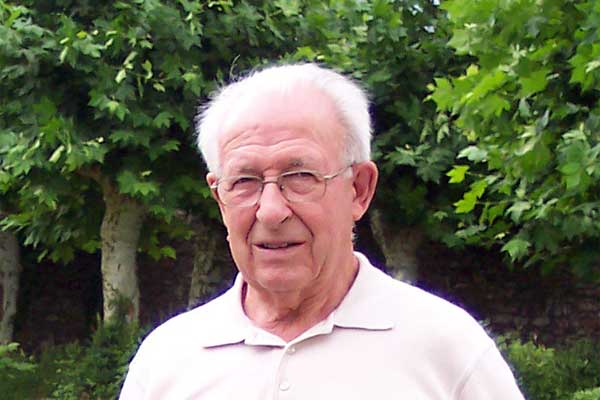
During the General Chapter of 1909 which was held in Spain the General Council was asked to buy a piece of land in Irun with a view to erecting the community headquarters of the new apostolic school. It was finally built on land bought at Hondarribia and opened its doors on 7th October 1910. That was 100 years ago. Fr Jose Gogorza, older brother of Mgr Ignace Gogorza SCJ, and bishop of Encarnacion, in Paraguay, is the privileged witness of this long story.
Nef: Fr Jose, could you very briefly describe your mission in Mendelu (sector of Hondarribia)?
- For 8 years I was in charge of the apostolic school with about 100 pupils; I spent 31 years as Parish Priest; from 1961 to 1970, which marks the beginning of the crisis in vocations and in the Church, the apostolic school was slowly declining. In face of that, the General Council asked us to open up to other ministries and to other apostolic sectors. This led to the foundation in Saragossa. Next it was the college in Azpeitia, which still exists but is now in the hands of the Bishop.
During all this time were there any really difficult moments?
- My own personal experience dates from the time when I had the feeling of being abandoned by my Superiors; after being trusted by them and then thrown to one side like an old rag...! I also suffered from the way Saragossa was founded. To my way of thinking we lost a good opportunity for opening up a more apostolic mission by making two errors. On the one hand by appointing members of the community more for youth formation rather than for the apostolic mission; on the other hand by hastily opening the scholasticate in a haphazard fashion.
What contributed to the flourishing of your Betharramite vocation?
- To begin with I would say that I didnt reduce my priesthood to teaching. Finally I found my own way despite my reservations and thanks to the advice of a great Betharramite. One day, noticing my shyness and discretion he said to me Jose, be simply ready to accept whatever is asked of you. But what if I dont feel up to it? If you are being asked to do it, its a sign. It means that you have been judged capable of doing it.
How did the community become involved in the activities of the diocese?
- Following the creation of the Mendelu parish, we had to contact the Archdiocesan clergy, both so as to have some kind of collaboration and to update our knowledge of diocesan pastoral. A few years later, Fr Inaki dAzpiazu, an old Betharramite with whom I had become initiated in the prison service in Buenos Aires, came to see me. He had been appointed by the Bishop to strengthen the prison service in his diocese. Not knowing the local clergy, he asked me to be his secretary, since we had already worked together. Then the bishop named me Episcopal delegate for the Prison service of San Sebastian. After 18 years in this service and having reached my 80th birthday I asked the bishop to be relieved of my charge which he accepted. He then asked me to join the team in charge of Diocesan Pastoral... And Im still there.
Some Betharramites have been very attached to the presence of Betharram at Mendelu
- Yes, indeed! When I was at the apostolic school, Frs. Oxibar and Lauhle greatly impressed me by the way they cared for this community. Later on, Frs. Mirande and Cattaneo encouraged us to broaden the horizon of our mission. I also think of the Provincial Superiors, Frs. Carrere and Urani who didnt skimp on resources.
You have been awarded the Gold Medal by the town of Hondarribia. To what extent were you involved in the social life of the town to have such a mark of gratitude?
- Its quite simple. Our property which was well situated and well equipped with large buildings, a sports ground and a wood was concerned with the seminarians. Then once the seminarians had moved on our property was opened up to outsiders. Some buildings were used as classrooms; the part including the chapel was transformed into meeting rooms for the parish. This change was well accepted by people living in the sector, who were also able to use the sports ground and the wood. The town council was able to calm the displeasure of the people by offering them a space for sports, recreation and walks. This opening to the sector made it possible for the community to become involved in catechesis, first communions and confirmations. The youngsters themselves wanted to be involved. They were given a room on condition that they should realise two projects each year: something for the good of the sector and something for the good of the parish. They gladly accepted and so it is that each year there is a festival in honour of St Michael Garicoits with the participation of everyone which is the envy of the other sectors. For the past 32 years we have mounted a play depicting the Birth at Bethlehem with the greatest mobilisation of children, youngsters, parents and grandparents. The City Council took note of the revival of the sector which was once withdrawn and lifeless. And so from there to presenting the Gold Medal to the priest theres no distance!
With the closure of the apostolic school what has become of the community property?
- To be exact, the construction comprised three U shaped buildings. The upper floor formerly occupied by the seminarians was leased out for 15 years to a primary school and for another 15 for adult further education. For the last 9 years we have been trying to find a solution to make the property viable.
What future for this property belonging to our Family?
- After consulting with the authorities of the Congregation, we have at last reached a project. The General Council has allowed us to sell a part of the property at Mendelu for the construction of a Retirement Home. The proceeds of this sale will allow us to refurbish the building where the community is living, and in another building to construct 15 independent apartments with can be rented out to the future Retirement Home. The rent will help to cover the needs of the community.
 |
8. THE COMMUNISM AND THE MISSION IN TALI (december 1950-december 1951)by |
Recording Mission property and missionary staff. In February 1951 began the registering of all the Missionary property and staff. We were light years from the imprecise methods of the old China; everything had to be written down with details unknown to the most demanding of police officers; to register the staff everything had to be done in six copies on official paper together with photographs and the CV covering exactly the whole life of the missionary, bar one month. This huge volume of work kept three secretaries busy for a fortnight, working twelve hours a day.
New restrictions in the dwelling place and work of themissionary. In March 1951, three quarters of the buildings belonging to the mission in Tali were occupied first for Peoples meetings and then were definitely transformed into property for the Post Office.
Father Barcelonne, lost in his outlying district of Tchoukhoula was told to stay put , and the Catholic population was forbidden access to the church for Sunday services.
In May 1951 the four Fathers on the Burmese frontier were asked to go to Pao-Shan but with such insistence that they thought it wiser to go to Burma, thanks to the changing of the guard at the frontier.
Fr Saint-Guily, returning from Rangoon where he had gone to buy medicines, arrived at the Chinese frontier with a visa which was a few days out of date. After making him wait for weeks on end and after searching his luggage, the authorities expelled him from China.
The question of the three autonomies. By March 1951 the Communist Party launched in the newspapers and for all Christians in China the threefold slogan of the financial, missionary and administrative autonomy of progressive Christians. The Chinese church for the Chinese people was the formula suggested to the Catholics. The schismatic character was totally denounced right from the start in pamphlets widely distributed amongst the Catholics throughout the whole country by the Catholic Central Library in Shanghai, and afterwards in a collective letter from the entire Chinese Hierarchy. The police got hold of it and launched a hate campaign against imperialists in disguise. They arrested priests and bishops, worked up spontaneous demonstrations composed of patriotic Christians. Despite everything, there were no definite results. There was nobody on their side except a tiny minority of Christians with a very heavy criminal record, along side of a few elements of the native clergy who were clearly terrified.
Document Actions









